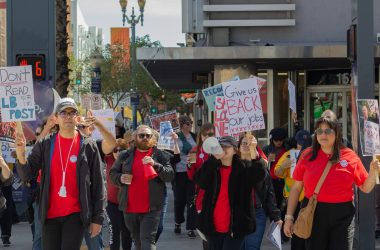Despite a lack of funds from the Southern California department the City of Long Beach will still help fund residential turf removal projects.
As of last week, the Metropolitan Water District of Southern California exhausted its entire turf removal budget, and as a result, will no longer fund any turf removal projects. Southern California helped to remove $450 million worth of turf from residential landscapes.
The Long Beach Water Department stated in a press release on July 9 that it would provide $2.50 per square foot of turf for its Lawn-to-Garden program. The program used to subsidize $3.50, with the help of the Metropolitan Water District budget.
“Converting landscapes from grass to drought tolerant plants is one of the biggest lifestyle changes a resident can make to save water during this unprecedented drought,” Harry Saltzgaver, the president of the Board of Water Commissioners, said in the press release. “Long Beach will continue to support these important efforts as strongly as we can without the assistance of Metropolitan’s funding.”
The Lawn-to-Garden program subsidizes a maximum of 1,000 square feet for Long Beach residents. On average, it costs $2.35 per square foot of turf removal in the 90815 zipcode, according to homewyse.com. The cost goes up and down depending on the total area being removed.
So far, the city of Long Beach has converted 2 million square feet of residential and commercial turf to drought resistant landscapes, according to the press release. The Long Beach Water Department will also subsidize $1 per square foot of synthetic turf installment.
To be eligible for the funding, residents must complete an online landscaping class and submit a drought-friendly landscape design for approval. Plants used in the landscaping design must cover 65 percent of the landscaped area and must either be California native or rated as “low” or “very low” water consumers, according to the Lawn-to-Garden website.
“We view the conversion from grass lawns to beautiful, water-conserving landscapes not as a temporary drought response, but as a long-term change which all of California must embrace to respond to the realities of our water supply imbalance,” Kevin Wattier, the general manager of the Long Beach Water Department said in the press release. “All of California needs to permanently reduce its water consumption, and landscape conversion is the key to getting there.”
In response to the drought, the State Water Resources Control Board ordered Long Beach in 2013 to reduce water usage by 16 percent by the next year. Last month, Long Beach reduced its water usage by 19 percent for the first time since the order.
California State University, Long Beach is converting six turf sites on campus to drought resistant landscapes over the summer. Brian McKinnon, the Facilities Management manager for grounds and landscaping said that the new landscaping could save 3.5 million gallons of water per year and $15,000 in water-related maintenance.
Paul Wingco, the Energy and Sustainability Manager of Facilities Management said that CSULB spends approximately $300,000 annually on watering landscaping. About 50 to 60 percent of the school’s water budget is spent on landscaping, Wingco said.
According to Lawn-to-Garden, about half of the city’s water usage is used on landscape irrigation, but drought-resistant landscaping can reduce water use per square foot by 70 percent.




